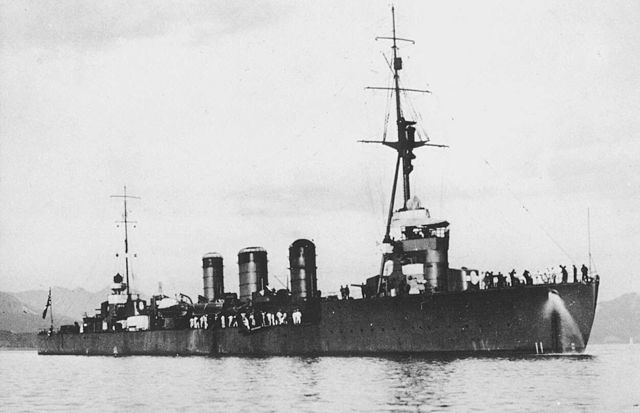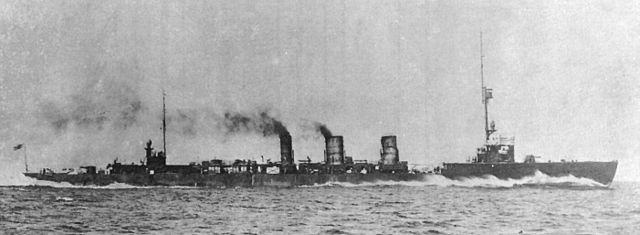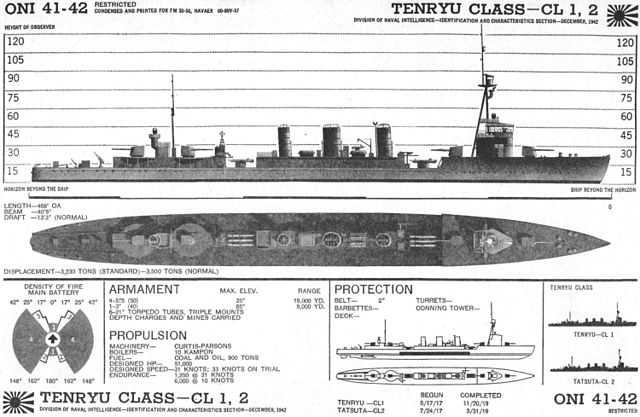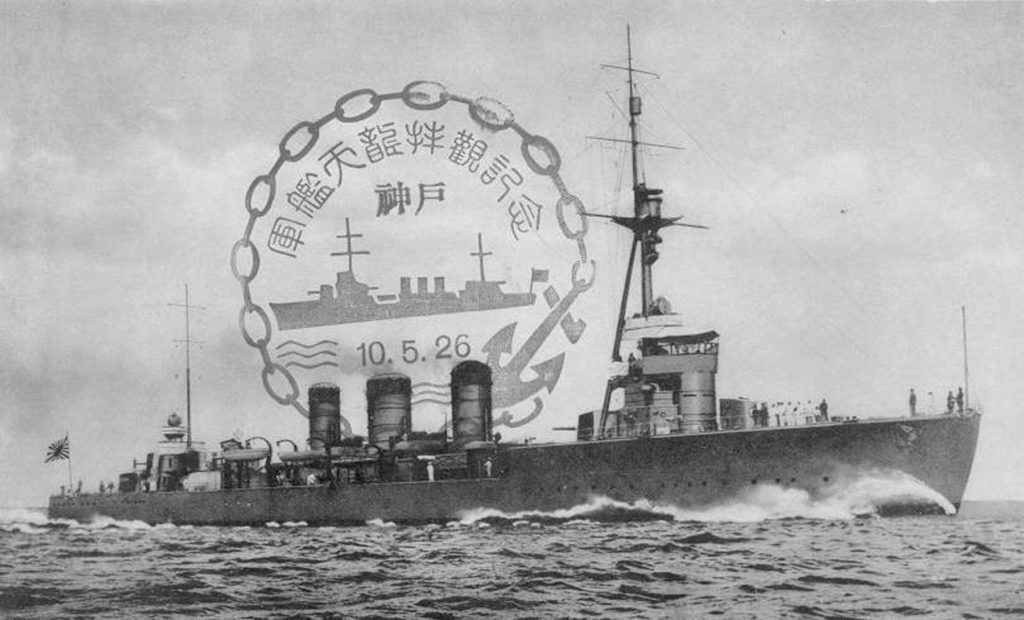First light cruisers of the IJN: The 天龍型軽巡洋艦 Tenryū-gata keijun’yōkan or Tenryū class has been the IJN first light cruisers.
If the ‘three and four pipers’ cruisers of the Kuma, Nagara and Sendai classes are better known, they constituted an evolution of two precursors, built during the great war.
Indeed, the Tenryu and Tatsuta were defined by the Admiralty in 1916 which wanted a kind of “super destroyer” based on the British design of the Arethusa and “C” class cruisers. Under the name of project 33, these ships were laid down in 1917, two months apart, at the Yokosuka and Sasebo shipyards. They had been defined as capable destroyer leaders moving at 33 knots, flagships for destroyer flotillas.
They also received the new 140 mm cannons developed for the Ise class battleships. They were also the first to benefit from triple torpedo tubes banks. By doing so, the admiralty defined the first IJN light cruisers, as Previous ships indeed has been protected or armoured cruisers.

Japanese cruiser Tenryu in 1930
Design of the Tenryū
The closest ships in the same area has been the Chikuma-class cruisers (1918), modelled after the Town class cruisers, but still defined as protected cruisers rather than “light cruisers”. The admirarlty wanted a design in between these 5000 tons ships and the 1400 tons destroyers, the largest then on offer, the Kawakaze-class.
However with its price tag (4.55 million yen apiece) and after thought limited capabilities, this design was not followed. The Kawakaze was almost as well armed but much faster, and later designs like the AA American cruisers of the Omaha class and British Dido proved much better on the other side of the spectrum. By 1935-1936 the admiralty discussed planes for a conversion into a true specialized AA/ASW cruiser with eight 127 mm guns in dual turrets, eight 25-mm guns and four depth charge launchers, new boilers with one single truncated funnel, but although it was registered in FY 1937, this never happened due to Japanese Shipyards already full capacity.
Later yet another conversion proposal stated the ship could be converted with the simple addition of eight Type 98 76.2 mm guns, but the plan, again, never materialized. In fact Japan will have its specialized dual purpose “super-destroyers”, the Akizuki class in 1942.
However by the time they were constructed, these small cruisers multiplied innovations. Despite their small size, they had more horsepower per ton than the Chikuma, thanks to the combination of oil-fired boilers and Brown Curtiss geared turbine engines. The three set of turbines gave the record 33 knots (61 km/h). Yet as coal depots were still numerous, two of the boilers were mixed-firing. However on the armament sizen even by the standards of the time she was weakly armed, with only four main gun, individual mounts on the bridge axis. However these were brand new 14 cm/50 3rd Year Type naval guns, also used on the Ise battleships.

IJN Tenryu in 1919 under trials

ONI – recoignition plate of the Tenryu, US Navy
Too late for the great war
Although no conversion ever took place, in 1930 and 1933 respectively both Japanese light cruisers were renovated: A a modified bow superstructure was fitted, the canvas sides being replaced by steel plates, the mast were lowered to improved stability and in 1936, the bridge was reinforced by additional steel plating against shrapnel. In 1937 at last AA threats were recoignised with the addition of two Type 93 13 mm AA HMGs in single mounts.
They were fitted on platforms close to the first funnel but were replaced in 1940 by much more efficient twin-mount Type 96 25 mm AA guns. By 1937 also the 8 cm/40 naval guns were obsolete and they were removed. However since these vessels were second rate when the war started, wartime modifications were light, with only two Type 96 25-mm twin mounts fitted when the ships were anchored at Truk in February 1942. Tatsuta however would receive a fifth Type 96 twin mount (August 1943 refit). The Tatsuta however apparently kept her own 78 mm on the rear deck.
During their long active career (they were launched in 1918 and completed in 1919), both cruisers were too weak compared to the standards for IJN cuisers and were considered second-class. They mostly performed as escorts. In short, the Tenryu was sunk on December 18, 1942 by an American submarine, the USS Albacore. The Tatsuta survived until April 1944, to be torpedoed and sunk by another submarine, the USS Sandlance.
Prior to the war, IJN Tenryu participated in the Siberian Intervention. She also performed Yangtze River patrols and when the war started, she supported Japanese landings along the China coast. She participated in the Battle of Wake Island and the invasions of the Solomon Islands. She also took part in the New Guinea, Tulagi campaigns, and the famous Battle of Savo Island, during which she apparently torpedoed the USS Quincy (CA-39). She was sunk after the Battle of Guadalcanal by USS Albacore, and struck on 20 January 1943.
The IJN Tatsuta also participated in the Siberian Intervention, and also covered IJN troops landings of along the China coast when the war erupted. She took part in the Battle of Wake Island and the Solomon Islands landings. She was also in action in New Guinea, Tulagi, and also took part in Battle of Savo Island, and later the Naval Battle of Guadalcanal, but survived unlike her sister-ship.
So she was retained in Japanese home waters because of the lack of spare oil as guardship in 1943, performing training duties, but sunk 13 March 1944 en route to Saipan in her last, one-ticket mission by the submarine USS Sand Lance, approximately 40 nautical miles or 74 km north-north-east of Hachijōjima. She was struck on 10 May 1944 and broken up later. Despite their age, both cruisers were thrown into the furnace of the Pacific war to the full.
Specifications of the Tenryū in 1941
Displacement: 3 948 t. standard -4 350 t. Fully Loaded
Dimensions: 142,9 m long, 12,3 m wide, 4 m draft
Propulsion: 3 propellers, 3 turbines, 10 mixed boilers, 51 000 hp; Top speed 33 nœuds
Armour: 51 mm belt, 25 mm deck
Armament: 4 x 140 mm (4.8 in) (4×1), 1 x 78 mm AA (3.1 in), 8 de 25 mm AA (1.1 in), 2 x 13.2 mm HMG (0.5 in) AA, 6 x 610 mm TTs (22 in)(2×3)
Crew: 340
Read More
http://www.combinedfleet.com/tenryu_t.htm
en.wikipedia.org/wiki/Tenry%C5%AB-class_cruiser
Conway’s all the world’s fighting ships 1906-1921

Illustration of the cruiser Tatsuta



 Latest Facebook Entry -
Latest Facebook Entry -  X(Tweeter) Naval Encyclopedia's deck archive
X(Tweeter) Naval Encyclopedia's deck archive Instagram (@navalencyc)
Instagram (@navalencyc)





 Austrian Navy
Austrian Navy French Navy
French Navy Royal Navy
Royal Navy Armada Espanola
Armada Espanola K.u.K. Kriegsmarine
K.u.K. Kriegsmarine Dansk Marine
Dansk Marine Nautiko Hellenon
Nautiko Hellenon Koninklije Marine 1870
Koninklije Marine 1870 Marinha do Brasil
Marinha do Brasil Osmanlı Donanması
Osmanlı Donanması Marina Do Peru
Marina Do Peru Marinha do Portugal
Marinha do Portugal Regia Marina 1870
Regia Marina 1870 Nihhon Kaigun 1870
Nihhon Kaigun 1870 Preußische Marine 1870
Preußische Marine 1870 Russkiy Flot 1870
Russkiy Flot 1870 Svenska marinen
Svenska marinen Søværnet
Søværnet Union Navy
Union Navy Confederate Navy
Confederate Navy Armada de Argentina
Armada de Argentina Imperial Chinese Navy
Imperial Chinese Navy Marinha do Portugal
Marinha do Portugal Mexico
Mexico Kaiserliche Marine
Kaiserliche Marine 1898 US Navy
1898 US Navy Russkiy Flot
Russkiy Flot French Naval Aviation
French Naval Aviation Russian Naval Aviation
Russian Naval Aviation Sovietskiy Flot
Sovietskiy Flot Royal Canadian Navy
Royal Canadian Navy Royal Australian Navy
Royal Australian Navy RNZN Fleet
RNZN Fleet Chinese Navy 1937
Chinese Navy 1937 Kriegsmarine
Kriegsmarine Chilean Navy
Chilean Navy Danish Navy
Danish Navy Finnish Navy
Finnish Navy Hellenic Navy
Hellenic Navy Polish Navy
Polish Navy Romanian Navy
Romanian Navy Turkish Navy
Turkish Navy Royal Yugoslav Navy
Royal Yugoslav Navy Royal Thai Navy
Royal Thai Navy Minor Navies
Minor Navies Albania
Albania Austria
Austria Belgium
Belgium Columbia
Columbia Costa Rica
Costa Rica Cuba
Cuba Czechoslovakia
Czechoslovakia Dominican Republic
Dominican Republic Haiti
Haiti Hungary
Hungary Honduras
Honduras Estonia
Estonia Iceland
Iceland Eire
Eire Equador
Equador Iran
Iran Iraq
Iraq Latvia
Latvia Liberia
Liberia Lithuania
Lithuania Mandchukuo
Mandchukuo Morocco
Morocco Nicaragua
Nicaragua Persia
Persia San Salvador
San Salvador Sarawak
Sarawak Uruguay
Uruguay Venezuela
Venezuela Zanzibar
Zanzibar Warsaw Pact Navies
Warsaw Pact Navies Bulgaria
Bulgaria Hungary
Hungary

 Bundesmarine
Bundesmarine Dutch Navy
Dutch Navy Hellenic Navy
Hellenic Navy Marina Militare
Marina Militare Taiwanese Navy
Taiwanese Navy Chinese Navy
Chinese Navy Indian Navy
Indian Navy Indonesian Navy
Indonesian Navy JMSDF
JMSDF North Korean Navy
North Korean Navy Philippines Navy
Philippines Navy ROKN
ROKN IDF Navy
IDF Navy Royal New Zealand Navy
Royal New Zealand Navy Egyptian Navy
Egyptian Navy South African Navy
South African Navy

































 RN
RN
 Marine Nationale
Marine Nationale
 Soviet Navy
Soviet Navy
 dbodesign
dbodesign